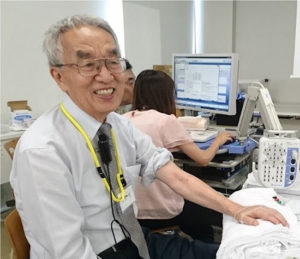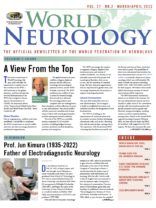By Ryuji Kaji
 Dr. Jun Kimura was born on Feb. 25, 1935, in Kyoto, Japan, and was brought up in Takayama, a scenic rural place near Kyoto. He once graduated from School of Technology in 1957, but re-entered Medical School of Kyoto University, and obtained MD (1961). He was granted a Fulbright Scholarship (1962-1967), and began his career at the University of Iowa School of Medicine as a medical resident and fellow (1962-1968), associate professor (1972-1977), and professor (1977-1988).
Dr. Jun Kimura was born on Feb. 25, 1935, in Kyoto, Japan, and was brought up in Takayama, a scenic rural place near Kyoto. He once graduated from School of Technology in 1957, but re-entered Medical School of Kyoto University, and obtained MD (1961). He was granted a Fulbright Scholarship (1962-1967), and began his career at the University of Iowa School of Medicine as a medical resident and fellow (1962-1968), associate professor (1972-1977), and professor (1977-1988).
I first met him in my junior neurology residency in 1981, when he was invited to give a lecture on blink reflex and facial palsy at the time of the World Congress of Neurology in Kyoto. I was fascinated by his unique way of presentation, both informative and amusing. After his talk, I tried to talk to him in English, but was surprised to hear his Japanese reply. Having had a few minutes of conversation, I became aware of his kindness, generosity, and humility. He published a famous textbook, “Electrodiagnosis in Diseases of Nerve and Muscle: Principles and Practice,” in 1983, which at once became the standard for neurologists, and determined my career as an electromyographer.
After completing my MD, PhD course in Kyoto, I was fortunate to have a position of clinical fellow at the Hospital of the University of Pennsylvania in 1985, and Dr. Austin Sumner became my first mentor of EMG. Dr. John England, currently the editor of Journal of the Neurological Sciences, was my colleague at Dr. Sumner’s EMG laboratory. We used to bet a box lunch on the diagnosis. At that time (1985 – 1986), Dr. Kimura served as president of American Association of Electrodiagnostic Medicine. In 1987, I received an international call from the dean of my alma mater, the head of the search committee, who asked me to persuade Dr. Kimura to go back to Kyoto University as professor and chair of the department of neurology. First, he declined the offer, since he already had a solid background, reputation, and family in the United States. I had to visit his home in Iowa to ask him to change his mind. After a while, he agreed to go back to Kyoto on the condition that I follow him to help adjust to the Japanese style of life. For possible projects, we discussed starting botulinum toxin injections for neurological disorders with the skill of EMG for the first time in Japan, and Kyoto became a center for botulinum toxin therapy.
His wife, Mrs. Junko Kimura, was kind enough to go back with him, which made my task much easier. In fact, she was helping edit the journal Muscle and Nerve in Kyoto, while Dr. Kimura was the chief editor. Dr. Kimura thus became my second mentor of EMG, and I learned much from him not only on science, but also on career. He was soon elected as the president of the International Federation of Clinical Neurophysiology (IFCN) in 1990.
Despite his busy professional activities, he encouraged us to run research activities in Kyoto: discovery of the use of IVIg for multifocal motor neuropathy (1989, 1991), clinical trials of Japanese botulinum toxins including type F, exploring the pathophysiology of dystonia, and clinical development of ultra-high dose methylcobalamin for ALS, which will be officially approved soon in Japan.
He was humble enough not to put his contribution too much on every work, and was kindly looking after every young fellow, including myself. His mottos included “Care for the patients” and “To see central (nervous system) from peripheral.” He attracted dozens of medical students to become neurologists. In 1991, we were fortunate enough to have Dr. Hiroshi Shibasaki as the professor of clinical neurophysiology, while Dr. Kimura served as the neurology chair, and both groups collaborated successfully, making Kyoto the mecca of clinical neurophysiology then.
During those productive years, we decided to convene the International Congress of EMG and Clinical Neurophysiology (10th ICEMGCN), the official congress of IFCN, 1995, in Kyoto. Because Dr. Kimura had few connections with the industry then, we tried our best to raise funds for the congress. Fortunately, the meeting was very successful with a record number of participants, and the surplus funds were donated to the national funds for neuropsychiatric diseases.
After he was elected as the first vice president of the WFN in 1998, he asked the national fund to further donate the money to help publish World Neurology. On his retirement in 1998 in Kyoto, he returned to Iowa, but was often seen in Kyoto with his wife and disciples in later years.
When he was inaugurated as president of the WFN in 2002, he made a number of reforms to the federation, such as constitution and bylaws, finance, and membership of the WFN. During and after his presidency, he was keen about education of young neurologists in Asian, Arab, and Latin American countries, and traveled virtually all around the globe many times. Wherever he went for EMG hands-on, he packed the room with young neurologists. His educational activities went on tirelessly for the rest of his life. When he was asked to visit some developing countries, he was kind enough to travel in economy class using his mileage of the airline company.
I was appointed as the chair of the neurology department in Tokushima in 2000, and thanks to his promotion, I took an executive position (member-at-large) of IFCN during 2001-2006. At the end of my term, Dr. Kimura, Dr. Andrew Eisen (treasurer of IFCN), and I discussed the need for new electrodiagnostic criteria for ALS, which make it possible to start any test drug for ALS as early as possible in clinical trials, since we knew that the number of spinal motoneurons are decreased below 30% of normal at the time of diagnosis using El Escorial criteria. Thus, we held a consensus meeting in Awaji Island near Tokushima to set the currently known “Awaji Criteria.” A pivotal phase 3 trial of ultra-high dose methylcobalamin (JETALS), funded by the Japanese government, used these criteria for entry, and was successful in detecting ALS at the early stage.
During 2007-2013, I served as trustee of the WFN for two terms. For the second term, I was appointed as the chair of the Asia Initiative by Dr. Vladimir Hachinski, then-president of WFN, to revitalize neurology in Asia, which is the most densely populated region in the world. The mission was tough, but Dr. Kimura’s seeds in young Asian neurologists became the fruitful core of many Asian neurological societies.
At the WCN 2016, the second congress in Kyoto, I was elected as first vice president of the WFN and worked mainly on organizing the congress. At the end of my term in 2021, Dr. Kimura was helping me to run for the president with all his might. After the results were announced, he seemed to be extremely exhausted. He passed away unexpectedly in his sleep on March 3, 2022. My last e-mail to him was to celebrate his 87th birthday on Feb. 25. He replied with a message that he was writing the new version of his textbook and looking forward to coming back to Kyoto in April.
He is survived by his wife Junko and three sons: Ken, Ray, and Joe and his wife Lori, and his grandchildren.
His last but the most important motto was “use EMG like a hammer,” and I believe he is still enjoying teaching EMG in heaven. •
Ryuji Kaji, former vice president of WFN, is a Distinguished Professor of Neurology at Tokushima University. He is also the director of Utano National Hospital in Kyoto.
